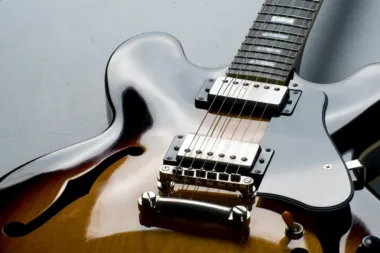
Regular cleaning not only preserves the strings' sound but also prevents frequent replacements, making your guitar playing more enjoyable and cost-effective. This guide offers step-by-step instructions and professional tips on how to clean guitar strings, ensuring they remain in top condition, ready to produce the rich, clear sound that every guitarist strives for.
Understanding the nuances of different string types and their maintenance requirements is essential. Whether you play electric, acoustic, or bass guitar, each string type demands specific care. In this guide, we'll cover various cleaning methods suitable for all string types, discuss the best cleaning products, and explore homemade solutions for those who prefer a DIY approach. By the end of this guide, you'll have a wealth of knowledge on maintaining your guitar strings, ensuring that every note you play resonates with the utmost clarity and vibrancy.
How Guitar Strings Get Dirty
The process of how guitar strings get dirty is straightforward. As you play, your fingers and palms transfer sweat, oils, and even dead skin cells onto the strings. This combination of substances can lead to corrosion and a loss of responsiveness in the strings. Regular cleaning is essential to prevent this buildup, which can collect in the windings and dull the sound quality. Various hand formulas and products are available to help prevent tarnish buildup on the strings.
To restore your guitar's tone, you'll either need to clean the strings or replace them. Flatwound strings, in contrast to roundwound, have fewer crevices and are less likely to accumulate oils and grime. Due to their design, flatwound strings also tend to sound newer for longer periods and require less frequent restringing.
When to Clean Your Strings

Identifying the right time for how to clean guitar strings is crucial for maintaining your guitar's sound quality. The strings' ability to vibrate freely is what produces the guitar's sound, and when they're new, they offer a bright, distinct tone due to unimpeded high-frequency vibrations. Over time, factors like finger oils, dirt, and environmental dust accumulate on the strings, dulling this vibrancy. Regular cleaning of your guitar strings is key to preserving their sound. This is particularly important if you often play in different environments or use products that can leave residues on the strings. These residues, once lodged in the string windings, shorten the sustain and make the tone duller. Knowing how to clean guitar strings effectively becomes a vital skill to restore and maintain their tonal quality.
Moreover, the frequency and style of playing, along with individual factors like the acidity of one's sweat, significantly affect how quickly strings get dirty. Integrating string cleaning into your regular guitar maintenance routine is a proactive step in enhancing string longevity and performance. This guide will delve into various cleaning methods suitable for different usage scenarios, providing you with comprehensive knowledge on how to clean guitar strings in any circumstance.
Clean Every Time You Play
One of the simplest yet most effective ways to maintain your strings is to clean them every time you play. This involves wiping down your guitar before and after playing to ensure no moisture or debris remains on the strings or pickups. Microfiber cloths are ideal for this purpose, as they effectively clean guitar strings without leaving any residue. In addition to wiping down the guitar, it’s advisable to regularly wash your hands to remove any excess oils, grease, or other substances that could transfer to the strings. Keeping a small towel nearby to dry sweaty hands during a performance can also help in keeping your strings clean.
Before playing, use a microfiber cloth to gently wipe any moisture or dust from the strings, pickups, and neck. After playing, give your guitar a thorough cleaning, focusing on the strings, fretboard, pickups, tuning machines, and the body. This routine helps in maintaining the guitar's overall condition and plays a vital role in how to clean guitar strings effectively.
Clean Before Shows or Recording
For musicians who perform live or record, putting on a fresh set of strings for each show or session ensures the best sound quality. However, if your strings are still in good condition, cleaning them might be a more practical choice. Knowing how to clean guitar strings properly can prolong their life and maintain a clear tone for longer periods, delaying the need for a new set. When cleaning your strings, particularly for unfinished fretboards, it's important to prevent overexposure to the cleaner. Placing a towel underneath the strings while applying cleaner can protect the fretboard. Finished fretboards are more resilient, but still, care should be taken when applying any cleaning solution.
How to Clean Guitar Strings
Cleaning your guitar strings is a critical aspect of maintaining the instrument's overall sound and playability. The process of how to clean guitar strings is straightforward but requires attention to detail to ensure that the strings are cared for properly without causing any damage.
Materials Needed:
- Microfiber Cloth: Essential for wiping down the strings without leaving residue or lint.
- String Cleaner: A specialized cleaner formulated for guitar strings.
- Soft Brush: Optional, for dislodging any debris from the string windings.
1. Loosen the Strings
Gently loosen the strings to allow easier access for cleaning. This step is crucial for reaching the entire surface of each string.
2. Apply String Cleaner
Spray or apply a small amount of the string cleaner onto a microfiber cloth. Avoid applying cleaner directly onto the strings or guitar body to prevent any potential damage.
3. Wipe Each String
Firmly hold the cloth around each string and slide it up and down the length of the string. This motion helps in removing dirt and oils that have accumulated. Ensure to clean the entire length, from the bridge to the nut.
4. Clean the String Windings
For deeper cleaning, especially if the strings have visible debris in the windings, use a soft brush. Gently brush along the strings to dislodge any trapped dirt. Be cautious not to press too hard as this could damage the strings.
5. Wipe Down Again
After brushing, use the microfiber cloth for a final wipe to remove any loosened debris and excess cleaner.
6. Dry the Strings
Ensure that the strings are thoroughly dry before tuning them back to pitch. Any leftover moisture can lead to corrosion and reduce the lifespan of the strings.
7. Tune and Test
Once the strings are clean and dry, tune your guitar back to your desired pitch. Play a few notes and chords to ensure that the cleaning process has restored the brightness and clarity of the strings.
Avoiding Household Cleaners
A critical step in understanding how to clean guitar strings is knowing what products to avoid. Common household cleaners, such as bleach or soap, are unsuitable for guitar strings. These substances can cause damage to the strings and potentially harm the guitar's finish. The safest way to clean guitar strings is to use products specifically designed for them. Commercial guitar string cleaners, combined with microfiber towels, offer a safe and effective solution for cleaning your strings. These specialized cleaners are formulated to gently remove dirt and oils without damaging the strings or the guitar's body.
Boiling Bass Strings
For bass guitar players, knowing how to clean guitar strings can include a unique method: boiling them. This technique can effectively remove built-up oils and debris from the strings. However, it's crucial to remember that boiling strings is a method that should be used sparingly, as it can weaken the strings over time. Careful handling of the boiling water is essential, and it’s important to allow the strings to completely cool and dry before restringing the bass. This method highlights the importance of having a reliable guitar string cleaner at hand for regular maintenance.
Cleaning the Guitar Fretboard

Different types of fretboards require specific approaches for cleaning and conditioning. For guitars with unfinished or raw wood fretboards, such as rosewood or ebony, using a dedicated fretboard conditioner is crucial. These conditioners clean while replenishing natural oils, preventing the wood from drying out and cracking. Apply the conditioner with a soft cloth, gently working it into the wood, and then remove any excess to avoid a greasy feel.
In contrast, guitars with finished fretboards, typically maple, require a different method. Here, a standard guitar cleaner is more appropriate. It’s sufficient to gently wipe the surface with a slightly damp cloth followed by a dry one to maintain its pristine look. Avoid using furniture polishes or harsh chemicals, as these can damage the finish or make the fretboard slippery.
Regular fretboard maintenance also includes attending to the frets themselves. Polishing the frets helps in keeping them smooth, enhancing playability. This can be done using fine-grade steel wool or specialized fret polishing tools. Ensure to protect the guitar's pickups from metal filings when doing so. A clean and well-maintained fretboard not only improves the feel and playability of your guitar but also contributes to the overall health of your strings and the sound of your instrument.
Cleaning the Guitar Body

The type of finish on your guitar dictates the appropriate cleaning method. For guitars with a matte or satin finish, opt for a cleaner that’s designed for these types of surfaces. These cleaners are gentle yet effective, removing fingerprints and grime without altering the natural look of the wood.
For glossy-finished guitars, using a high-quality guitar polish will not only clean but also protect the finish. Apply the polish with a microfiber cloth, working in small sections and buffing out to a shine. This not only keeps your guitar looking new but also protects the finish from the wear and tear of regular use.
While cleaning the body, pay attention to the areas around the bridge and pickups, where grime can accumulate. Use a soft-bristled brush or cotton swabs for these hard-to-reach areas to ensure thorough cleaning. Regularly cleaning the body of your guitar not only maintains its aesthetic appeal but also preserves its structural integrity, ensuring that your instrument remains a source of pride and joy for years to come.
When to Replace Strings
Knowing when to replace your strings is as important as knowing how to clean guitar strings. Signs that it's time for a new set include breakage, a noticeable decline in tone quality, or difficulty staying in tune. You might also want to change strings to adjust the playability or experiment with a different sound, which can be achieved by changing the string gauge or composition. For more details about restringing both electric and acoustic guitars, make sure to read our article on how to restring a guitar.
An essential skill for any guitarist
Mastering the art of cleaning your instrument is an essential skill for any musician that's committed to preserving their instrument's sound and longevity. Regular cleaning not only maintains the tone and responsiveness of your strings but also saves money and time in the long run. Whether it's through daily wipe-downs, specialized cleaning methods, or understanding when to replace strings, each aspect plays a crucial role in the care of your guitar. By adopting these practices, you ensure that your guitar remains in top condition, ready for any performance or recording session.
Remember, the process of how to clean guitar strings is not just about maintaining the strings themselves but about nurturing a deeper connection with your instrument. It's about understanding its nuances and responding to its needs. With this comprehensive guide, you're now equipped with the knowledge and techniques to keep your guitar sounding its best. So, embrace the routine of cleaning your guitar strings, and enjoy the beautiful music that follows.
Knowing how to clean guitar strings is a fundamental aspect of guitar maintenance that should not be overlooked. By following the detailed advice and tips provided in this guide, you can ensure that your guitar will continue to produce the beautiful sound you cherish for years to come.






Leave a Reply!
Hey guys. There are lots of good comments around, including right here on this site. Thanks to the providers for helping the community. HERE IS AN ADDITONAL COMMENT ABOUT STRING MAINTENANCE. String maintenance is perhaps the most under-rated maintenance matter for guitar users. Read the comments from THIS FORUM about string maintenance and follow the advice. For those who have questions about why tuning and intonation goes off so miserably as strings degrade, here is a semi-scientific explanation.,,,
For heavy benders, tappers, and forced harmonics platers, the strings do not go off all at the same rate. Chord players, for example, can enjoy generally stable intonation and tuning as the strings decline due to the fact that all of the strings are going off at about the same rate. But if, for example, you are a Vivian Campbell enthusiast, or you like playing George Lynch riffs and lead segments, your strings will decline according to a pattern that IS NOT linear. This means that you will have metal fatigue, flattening, micro-kinking and other deformities all over the place. Your D-string, B-string and A-string might have damage in places along the scale that are not the same as for other strings on your guitar. This means that the vibration pattern for a bar chord played at the seventh fret is completely different from the pattern produced when the same chord is played at the third fret. This is why you can succeed to tune your dull-stringed guitar in an open position and then find that a standard G-chord doesn't sound right. Individual notes may continue to sound okay all the way up the scale, but arpeggios will start to drop off as the number of notes in each sequence increases.
For this kind of case, DON'T adjust your intonation. Just change your strings. If you left your old strings on for a long time, as i sometimes do on my Strats, or change one string at a time (as I also do sometimes on my Strats), you my have pulled your intonation a little bit, or your intonation may have just "drifted" slightly. In this case, you should make some adjustments, AFTER putting on new strings.
'Sorry for the ramble. I get this question a lot, even from experienced players. That's ONE explanation among several.
'Hope those who read are enlightened and will not rush to adjust their guitar.